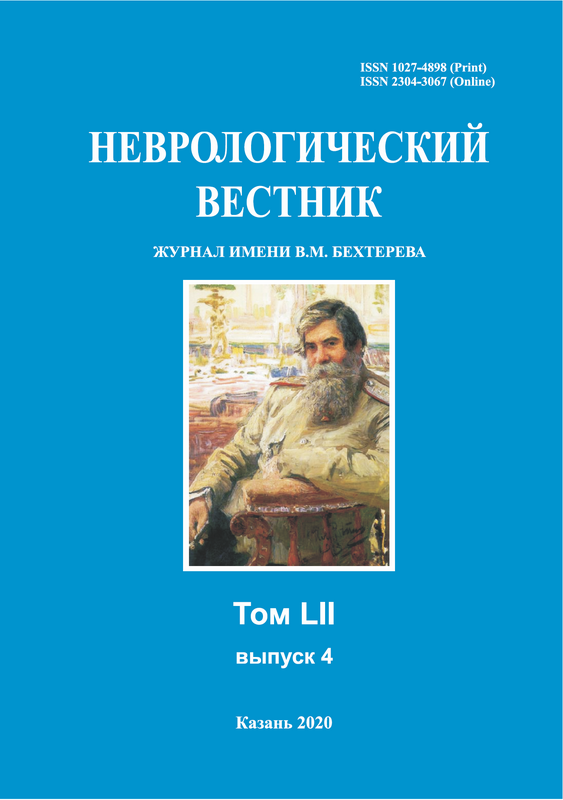Антиципационно-прогностическая регуляция моторных функций в восстановительном обучении пациентов, перенёсших ишемический инсульт (анализ клинических случаев)
- Авторы: Никишина В.Б.1, Петраш Е.А.1, Шутеева Т.В.2, Никишина Е.И.3
-
Учреждения:
- Российский национальный исследовательский медицинский университет им. Н.И. Пирогова
- Курский государственный медицинский университет
- Первый Московский государственный медицинский университет им. И.М. Сеченова
- Выпуск: Том LII, № 4 (2020)
- Страницы: 83-92
- Раздел: Клинические случаи
- Статья получена: 11.12.2019
- Статья одобрена: 25.11.2020
- Статья опубликована: 14.03.2021
- URL: https://journals.eco-vector.com/1027-4898/article/view/18626
- DOI: https://doi.org/10.17816/nb18626
- ID: 18626
Цитировать
Полный текст
Аннотация
Цель. Оценка эффективности антиципационно-прогностической регуляции в восстановительном обучении пациентов, перенёсших ишемический инсульт, с учётом уровня организации движений и локализации очага поражения.
Методы. Объём исследовательской выборки составил 17 пациентов (средний возраст 62,3±1,48 года). На основании локализации очага ишемического инсульта были сформированы две группы. В первую группу вошли 11 пациентов с локализацией очага ишемического инсульта в структурах мозжечка. Вторую группу составили 6 пациентов с поражением базальных ганглиев. Для оценки неврологического статуса использована шкала инсульта Национального института здоровья (NIHSS). Оценку выраженности моторных нарушений осуществляли с использованием функциональных нейропсихологических проб. Организация исследования включала три этапа: диагностический этап (предварительная диагностика гностических функций и функций праксиса); этап восстановительного обучения (с использованием програм-мно-аппаратного комплекса «Визуальная медицина»); этап повторной диагностики (оценка гностических функций и функций праксиса после завершения восстановительного обучения).
Результаты. В результате исследования установлено, что у пациентов, перенёсших ишемический инсульт с локализацией очага поражения в базальных ганглиях, возможна трансформация произвольного уровня организации движений в автоматизированные (без возможности автоматизации моторных программ). Реализация моторных программ им доступна только через речевое опосредование на произвольном уровне.
Выводы. У пациентов, перенёсших ишемический инсульт с локализацией очага поражения в структурах мозжечка, на произвольном уровне организации движений происходит восстановление выполнения как отдельных движений, так и моторных программ при условии речевого опосредования. При отсутствии речевого опосредования пациенты допускают ошибки преимущественно при выполнении отдельных движений, составляющих моторные программы. Это приводит к нарушению моторной программы. Вследствие морфологических ограничений автоматизация как отдельных движений, так и целостных моторных программ требует существенно большего времени. Выполнение моторных программ также доступно для данной категории пациентов на произвольном уровне организации движений под контролем речевого опосредования.
Полный текст
Об авторах
Вера Борисовна Никишина
Российский национальный исследовательский медицинский университет им. Н.И. Пирогова
Автор, ответственный за переписку.
Email: petrash@mail.ru
Россия, 117997, г. Москва, ул. Островитянова, 1
Екатерина Анатольевна Петраш
Российский национальный исследовательский медицинский университет им. Н.И. Пирогова
Email: petrash@mail.ru
Россия, 117997, г. Москва, ул. Островитянова, 1
Татьяна Владимировна Шутеева
Курский государственный медицинский университет
Email: petrash@mail.ru
Россия, 305041, г. Курск, ул. К. Маркса, 3
Елизавета Игоревна Никишина
Первый Московский государственный медицинский университет им. И.М. Сеченова
Email: petrash@mail.ru
Россия, 119146, г. Москва, ул. Большая Пироговская, 19с1
Список литературы
- Пирадов М.А., Максимова М.Ю., Танашян М.М. Инсульт. Пошаговая инструкция. М.: ГЭОТАР-Медиа. 2019; 272 с. [Piradov M.A., Maksimova M.Yu., Tanashyan M.M. Insul’t. Poshagovaya instrukciya. (Stroke. Step-by-step instruction.) M.: GEOTAR-Media. 2019; 272 р. (In Russ.)]
- Карпова Е.Н., Муравьёв К.А., Муравьёва В.Н. и др. Эпидемиология и факторы риска развития ишемического инсульта. Соврем. пробл. науки и образования. 2015; 4: 1–10. [Karpova E.N., Muravyov K.A., Muravyova V.N. et al. Epidemiology and risk factors for ischemic stroke. Sovremennye problemy nauki i obrazovaniya. 2015; 4: 1–10. (In Russ.)]
- Анохин П.К. Очерки по физиологии функциональных систем. М.: Медицина. 1975; 399 с. [Anohin P.K. Ocherki po fiziologii funkcional’nyh sistem. (Essays on the physiology of functional systems.) M.: Medicina. 1975; 399 р.] (In Russ.)
- Александров Ю.И. Психофизиологические закономерности научения и методы обучения. Психологич. ж. 2012; 33 (6): 5–19. [Alexandrov Yu.I. Psychophysiological laws of learning and teaching methods. Psihologicheskij zhurnal. 2012; 33 (6): 5–19. (In Russ.)]
- Никишина В.Б., Петраш Е.А. Реципрокная организация конструктивной деятельности у пациентов с ишемическим инсультом. Ж. неврол. и психиатрии им. C.C. Корсакова. 2017; 117 (3-2): 79–89. [Nikishina V.B., Petrash E.A. Reciprocal organization of constructive activity in patients with ischemic stroke. Zhurnal nevrologii i psihiatrii im. C.C. Korsakova. 2017; 117 (3-2): 79–89. (In Russ.)]
- Павлов И.П. Полное собрание сочинений. Т. 3, кн. 2. М., Л.: Издательство Академии Наук СССР. 1951; 240 с. [Pavlov I.P Polnoe sobranie sochinenij. (Full composition of writings.) T. 3, kn. 2. M.L.: Izdatelstvo Akademii Nauk SSSR. 1951; 240 р. (In Russ.)]
- Edelman G. Second nature: Brain science and human knowledge. Yale University Press. 2006; 203.
- Clark A. Whatever next? Predictive brains, situated agents, and the future of cognitive science. Behav. Brain Sci. 2013; 36 (3): 181–204. doi: 10.1017/S0140525X12000477.
- Фирилёва Ж.Е. Динамика восстановления физических (двигательных) качеств в процессе непрерывной реабилитации человека, перенёсшего инсульт. Соврем. пробл. науки и образования. 2018; 3: 48. [Firileva Zh.E. The dynamics of the restoration of physical (motor) qualities in the process of continuous rehabilitation of a person who has suffered a stroke. Sovremennye problemy nauki i obrazovaniya. 2018; 3: 48. (In Russ.)]
- Юй С.С., Шмонин А.А., Вербицкая Е.В. и др. Реабилитационный потенциал и удовлетворённость пациентов с острым нарушением мозгового кровообращения в России и Китае. Регионарное кровообращение и микроциркуляция. 2016; 15 (4 (60)): 82–88. [Yu S.S., Shmonin A.A., Verbitskaya E.V. et al. Rehabilitation potential and satisfaction of patients with acute cerebrovascular accident in Russia and China. Regionarnoe krovoobrashchenie i mikrocirkulyaciya. 2016; 15 (4 (60)): 82–88. (In Russ.)]
- Мельникова Е.А., Разумов А.Н. Влияние нейропсихологических особенностей на восстановление больных, перенёсших острое нарушение мозгового кровообращения. Вопр. курортологии, физиотерап. и леч. физ. культуры. 2016; 93 (2-2): 103–104. [Melnikova E.A., Razumov A.N. The influence of neuropsychological features on the recovery of patients who suffered an acute violation of cerebral circulation. Voprosy kurortologii, fizioterapii i lechebnoj fizicheskoj kul’tury. 2016; 93 (2-2): 103–104. (In Russ.)]
Дополнительные файлы











